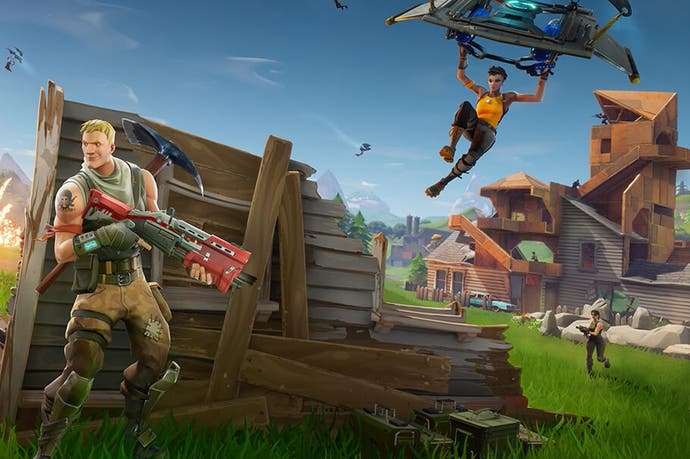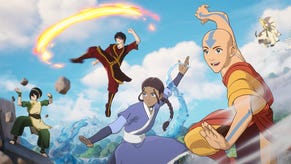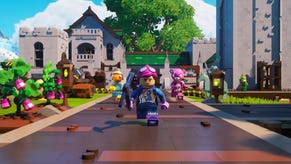Fortnite's on its way to being the world's biggest game, and here's what makes it special
Why save the world when you can knock it down?
Fortnite, like PUBG, is a game of a million different stories, but if you leap from the sky and aim straight for the house on Loot Lake you're often going to see one story in particular.
Loot Lake is situated near the centre of the Fortnite map, which means that the floating bus that crosses over the island as it deposits players always has a decent chance of coming near it. When it does, I find it an irresistible spot to head for: a lovely sagging mansion built of wood and slate, perched on a little mountain of mud and stone in the middle of still water. It conjures so many nice housey words, this place: gables, flagstones, manse. In truth, I would quite like to live here.
But others find it irresistible too, and hence we have the Groundhog Day scenario that the house on Loot Lake is caught within. I parachute in, and as I near the ground, I see someone else has had the same idea. This almost always happens. And what almost always happens next is a sort of polite agreement that takes place wordlessly in mid-air. The person closest to the house gets to pick the landing spot, and common sense dictates there are really only two spots to consider here anyway. So somebody gets the house and somebody else gets the roof and the snug attic below, which can be relied upon to contain a treasure chest. Digging down from the attic is dangerous - even dropping down into the garden has its hazards. Digging up into the attic is generally suicide. Voila! The person who gets the house has to live in proximity with the person who gets the attic, as virtual architecture combines with a few basic game mechanics to conjure the reliable psychodrama of a good ghost story. And so Fortnite imprints itself a little deeper, each time, upon my heart and my mind.
It was not meant to be like this. For years, Fortnite had shuffled and coughed uncomfortably on the horizon, a lavish, curiously hollow free-to-play project that sought to blend Minecraft-lite construction with something like Gears of War's Horde mode. People who went to play it during its development came back confused and a little sad: so much love and wit and energy here, but the pieces simply refused to converge. It made you think: Minecraft and Horde were staples of video games, but weren't they staples of very different games? More simply, why spend time building a beautiful fortress to protect at all costs if victory meant it was going to disappear forever once the match was finished anyway?
All that changed with PUBG. Suddenly, Fortnite was racking up millions of players, drawn to a hastily assembled PUBG knock-off. And it did, in theory, look an awful lot like a knock-off. The pre-match carnival of aimless violence on a holding-bay island just off the coast of the true arena. The route in, moving randomly over the drop zone. The ensuing battle to kill the 99 other players who had dropped with you, and then the end-game: the contracting iris that randomly chose one part of the map to head for, rendering everywhere else off-limits. A thrilling piece of design, but it was someone else's, surely?
And sure enough, in the early days of Fortnite's Battle Royale reinvention, it was hard not to load in and find yourself slightly disoriented. If you were used to PUBG - and it was one of the biggest games in the world by this point - it was same-but-different territory, encouraging a proprioceptive dizziness. No vehicles to snag while on foot the movement speed was different, right? Your character was larger and their connection to the ground suddenly seemed a little less slippery. UI furniture had moved around, health bar suddenly up there, player updates - DrunkPope shotgunned YungSnackBar - suddenly over here. And the war sim dust and devastation had been replaced with inoffensive cartoon cheer; a stack of tyres, which would be a cosmetic addition to the landscape in PUBG would now loft you into the air with a cartoon boing. Onwards and outwards: pick-ups hovered over the ground, bright colours announcing their rarity. You could no longer go prone.
Even taken superficially, it's clear that PUBG has been good for Fortnite, and not just because of the whole 45 million players, biggest-game-in-the-word thing. PUBG's impositions have been good for the design, sorting out a confused and overly busy game filled with voguish elements that refused to combine, and side-stepping the extraneous clutter of mindless reward systems, loot boxes, collectible cards and pinatas. Fortnite was a game with a lot of nice stuff, but beset with the hulking problem that none of its nice stuff actually mattered. Suddenly, though, suddenly it was lean and direct and PvP-focused, and it was beautifully energised by that roving circle - the shrinking lens of play that remains PUBG's true stroke of genius, setting your ambitions in inevitable conflict with the game's ambitions for this particular match.
The weird thing, though, is that on the ground, Fortnite didn't feel very much like a clone. It didn't always feel that much like PUBG at all, in fact. On my first game, days after the mode went live, I parachuted into the woods in a corner of the map, stumbled around, hit a few trees ineffectually, and was sniped by a distant stranger. Hardly an auspicious debut. But I went back in. And then I went back in again. And at first I think it was the map that was leading me back each time.
Fortnite's designers may have responded to PUBG with opportunism, but they also responded with craft, and the map is where this is most immediately apparent. Battle Royale's map is significantly smaller that PUBG's, but it is also built with very different ambitions. The tighter footprint means that the slow rolling shift from one kind of terrain to another that makes PUBG feel so innately wild and natural is replaced with a cluster of neighborhoods that can transition quite abruptly. PUBG has the space to build up the gradient until - Jesus! - you suddenly realise you're climbing a mountain. Fortnite relies on little IKEA hills that emerge from the ground in compact piles of rock. Want to get up high? Here's your chance. Equally, its urban spaces are caricatured plots of real-estate - the skyscraper district, the rundown mini-mall, the toilet factory - which feel entirely separate from the landscape around them. And they're meant to. PUBG's meant to feel wild, like you've been dropped into a warzone. Fortnite feels more like a paintballing team-builder held in a theme park.
More than anything, in fact, Fortnite's map is a series of little movie sets, many of which, like the house on Loot Lake, prod you towards a certain kind of drama. Take the skyscraper city, a relatively new addition that people are still getting to grips with. The first wave here is often about close-up weapons: you pick a roof and hope you get to the shotguns before the other people who have picked the same roof do. (The other day I was too late with this so I had to jump briskly into space before I was blasted to pieces: it was fun, and a bit like a movie). The second wave, though, once the idiots like me have all gotten themselves killed, is about sniping. It's about rooftop-to-rooftop sniping, but it's also about the hills that ring the city, filled with perfect spots to hunker down and pick your targets.
And Fortnite's map is filled with stuff like this, as well as with art design that, beneath the Nick Jr leaning walls and tilted picture frames, is capable of evoking a surprising range of different moods. One of the reasons this game pulls me back in again and again is that walking fifty yards in its world will take you somewhere new, from a swamp filled with hollow trees, perfect for the hiding of treasure chests, to rounded green hills and a blue sky right out of a Windows desktop wallpaper. It's all entirely readable on the fly, but it also has enough dynamic elements - butterflies fluttering and grass waving - to trick you into a dangerous burst of panic. And the designers of this movie are good at detailing, too. Serving no purpose other than making you think that someone, somewhere, really cared about getting this right, the stone circle that lies south-east of Tomato Town has a little visitor's plaque. I was so delighted to find it the other day that I stopped what I was doing and wandered over for a look, just long enough to be sniped from a distance. (Maybe that plaque does serve a purpose after all.)
Because of this richness, this playfulness, Fortnite is a surprisingly great game for watchers. You can watch it once you've been killed, of course, spectator mode brilliantly flipping your alliances as you urge your killer on to eventual victory. (Spectator mode also reveals the beauty of the Battle Royale genre's design, incidentally: this is a sort of ludic Maxwell's Demon, slowly bringing the best guns and the best equipment, along with the best players, into deadly proximity, entropy be damned.)
But you can also play as a watcher, hidden in a bush for gloriously empty minutes, wonderfully alone, the scope of your sniper rifle trained on a distant point of light that announces fancy loot. (The light of loot is not just great for creating traps; killing someone near your hiding spot provides a pinata's worth of evidence that you are lurking nearby with poor intentions.) You can pick your moment, or decide not to risk a kill and instead watch whatever drama then plays out, often within feet of you, the illicit pleasures of PUBG heightened by the smaller map and the awareness that you must inevitably live elbow to elbow with the people you are hunting.
Its flair for watching and waiting means that, like PUBG, bad players like myself can sometimes cameo our way into the big shoot-out at the finale, a terminal kind of patience sometimes depositing me at ground zero with absolutely no good weapons or gadgets. In Vegas, this is called f***ing the deck: poor players making life harder for the pros by springing moves that are so idiotic and grounded in ignorance that they are very hard for anyone even partially skilled to interpret or anticipate. In Fortnite, it's all part of the fun, to be the clown hidden at the edge of some epic conflict, and even learning a thing or two as the top players finish each other off nearby, each one of them presenting little lessons in expertise and in decisiveness, and all of this sharpened by the fact that the people who are teaching you are probably still in secondary school themselves.
And what you're often watching these Fortnite geniuses doing is...building. This is the biggest surprise in all of Battle Royale, perhaps, and the biggest weapon in any argument that battle royale modes are simply an emerging genre, with each new game that picks them up capable of turning them into something distinct. In vanilla Fortnite, in which you were generally defending a hub against oncoming hordes, building was both lavishly delivered and slightly meaningless. It was decked out for the kind of behaviour that the game neither required or encouraged. And it is weird to think, really, about how fortuitous all this was. As the team put together the mechanics that would never really come into focus in a PvE game, they were unintentionally laying an ideal framework for this opportunistic PvP off-shoot.
Building, then, works perfectly here. It works early in the game when you're scavenging for treasure chests and really need to get to a second storey attic if only you had a ramp or some kind of tower. It works beautifully as the arena contracts and you need to build fortifications. It works if you want to knock-up a quick decoy house while you flank and snipe. It works even if you're merely following in other players' footsteps, turning a game about shooting into a game about exploring a vast forensic crime scene puzzle.
And it works for three main reasons, I think. Firstly, it is a beautiful bit of risk/reward design. In a game about hiding, there are suddenly very good reasons for breaking cover and noisily chopping a tree down, or for emerging from the safety of a bush to build a very visible monument to your own presence.
Secondly, building grinds so brilliantly against the irising lens of play: you can fortify yourself in the perfect spot, but you'd also best understand that everything you build will become irrelevant if the game mindlessly shifts away from the territory you currently control. Building actually works with the iris to place another shoving hand on your back, in fact. You can miss the moment in more ways than one in Fortnite - getting trapped behind the storm, certainly, but also dallying too long in an ideal sniping spot that you eventually have to shift from, only to find that in the time it's taken you to up sticks, your enemies have built massive cathedrals to hide inside.
And that's the third reason, the last-five-minutes-of-the-game reason. Building in Battle Royale encourages flair. Genuine flair. All of it delivered with the mad Inception-style click-clacking of magical, impossible construction, of staircases that land in place even as you climb then, that little carpenter's pencil tilted, incongruously, in the hand while your palace erupts from the earth on all sides.
Oh, the end-games I have seen over the last few weeks. The sudden maze-offs, the mansions of befuddlement in which duals are fought with corridors and trick floors as much as with rocket launchers and shotguns. The up-ramps, a daring last minute dash to the heavens that is perhaps Fortnite's own signature move. There is something undeniably not just arresting but actually heroic about seeing someone running so confidently up into the sky along a path that they are creating as they go.
I have seen beauty here in Fortnite's dying moments - real, unmistakable beauty, which means, of course a drastic and fateful reversal of fortunes. I have seen players risk it all with a dash into the whirring, clicking radioactive chaos of the storm, before doubling back and emerging just behind a sniper's nest. I have seen players burrowing under enemy strongholds and erupting in a burst of gunfire. Last week, I saw a player with no shield and little health left, their fortress rattling to pieces under distant gunfire, suddenly bet everything on a jump-pad into the sky, followed by a silent arc through the clouds that placed them in perfect shotgun range of their entrenched foe.
That's it, isn't it? Risking everything on a surprise move, just as the light starts to die. Setting aside strategy and learning and just plunging forward. A win when a loss seemed certain. A drastic and fateful reversal of fortunes.












.png?width=291&height=164&fit=crop&quality=80&format=jpg&auto=webp)







